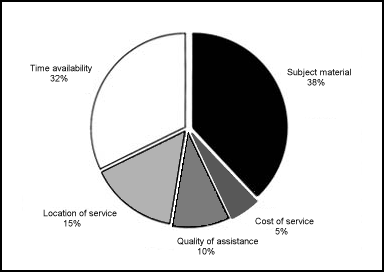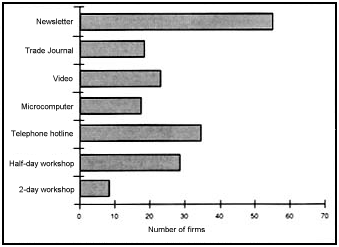Fall 1987 // Volume 25 // Number 3 // Feature Articles // 3FEA9
Tailoring Programs to Needs
Abstract
Recently, Extension has realized the importance of reaching beyond its traditional clientele to work with business and industry. Currently, some interest exists in refocusing part of the resources in the clothing and textiles area toward similar goals. This includes exploring the idea of helping this industrial sector, especially in states where those industries are critical to the economic well-being of many families.
Status of the Industry
New York State serves as a prime example of this economic dependence. The textile and apparel industries are vital to the economic stability of its manufacturing sector. As an employer of 145,000 people, the apparel sector alone ranks sixth in the state and first in New York City.1
In recent years, employment has declined dramatically due to increased imports and a lack of marketing orientation. This decline has been especially devastating to small firms, which represent the majority in this sector and are scattered in 47 of the 62 counties in the state. The most significant concentration is found in the metropolitan New York area, but textile and apparel firms can be found in every major city and throughout a few key counties. Over 1,000 establishments are located outside the metropolitan area.2
Organizations aimed at directly or indirectly helping this industrial sector do exist. However, some programs have been limited by budget cuts and other streamlining measures. Others have been too broad to be of assistance to small firms, which have very specific needs. Still others have simply been ineffective in reaching the industry. Because of the limitations of many of the present programs, new methods for developing more successful marketing and management techniques are needed and could possibly be provided through Cooperative Extension or other college-based programs.
This article: (1) reports the findings of a study designed to assess Extension's potential role, (2) outlines recommendations for the implementation of such a program, and (3) discusses possible roles for Extension agents, as well as the program's applicability to other business sectors.
New York Study
New York State, the major apparel producing state in the United States, was the focus of this project, which purpose was to assess the perceived information and assistance needs of the state's small apparel and textile manufacturers. The study examined the sources of information and help used by these firms, the kinds of information and help (marketing, technology) that were most needed, and the potential for Extension to help this sector.3
A statewide mail and telephone survey of 850 firms provided general information on the perceived needs of these firms. The results indicated that firms located outside New York City had a greater interest and need for university assistance programs and that marketing was the most needed type of assistance. Personal and telephone interviews were then conducted with owners from two specific industry segments throughout the state: apparel contractors and industrial fabricated product manufacturers.

Figure 1. Factors associated with Extension participation.
Recommendations for Implementation
The results of this study suggest that there's sufficient need and interest to warrant the further investigation and development of Cornell-based programs aimed at helping small apparel and textile firms outside the metropolitan New York area. Apparel and apparel-related textile product firms have a greater overall need for such a service, but industrial product firms shouldn't be excluded from assistance efforts.
Since many of the manufacturers surveyed said assistance programs presently in existence were simply too broad and required too great an expenditure of time, these characteristics should be avoided in the future. Variables influencing participation in Extension programs by these respondents are given in Figure 1. Subject material and time availability were the most frequently stated conditions. Thus, Extension programming needs to be highly specialized in content and concise in format.
To develop appropriate programming through Extension, it was necessary to survey media through which to provide this information and help. Equipment presently owned by manufacturers that might be used for Extension purposes was identified in addition to specific media channels (Figure 2). Microcomputers were owned by 42% of the sample, 43% owned video cassette recorders, 47% had tape recorders, and 30% owned slide projectors.
Possible Program Ideas
Here are some ideas to consider for this kind of programming:
- A series of newsletters to provide information on specific topics such as government and industry assistance programs, various government regulations and tax information, new manufacturing technology, marketing tools for small manufacturers, and other business related topics. The newsletters should be short, concise, and specifically related to textiles and apparel.
- Another series of seasonal newsletters to provide information on market trends for specific industry segments. Included in the type of information reported might be consumer data, product successes and failures, and data on imports. Examples of some of these segments might include apparel contractors, canvas product manufacturers, uniform manufacturers, and women's and misses' sportswear manufacturers.
- Information on a variety of topics provided through a telephone hotline system. Apparel and textile manufacturers might call to inquire about procedures for procuring government contracts, trends in potential target market groups, the quality of various Small Business Administration programs, and numerous other informational needs relating to apparel and textile production.
- Specialized media programs, if a large enough group of manufacturers with similar needs could be identified. For example, a videotape aimed at teaching production workers the techniques of sewing with heavy canvas fabrics could save businessowners both the time and expense of one-to-one training.
- Another role for Extension might be as a liaison between this industry sector and the local and state governments. Extension faculty and associates could, for example, encourage simplification of the state government contract procurement procedures for clothing and textile products.

Figure 2. Media to disseminate information or provide help.
Extension Agents' Role
Possible roles for agents in designing and implementing a program of this kind depend on the particular program selected, as well as the expertise and special skills of the agents involved. In the earliest stages of design, the agent can serve as an important contact in the business community, someone who knows the local entrepreneurs and therefore has access to important information.
The agent, perhaps with the help of trained volunteers, could gather data to determine the parameters of individual county programs. County offices might serve as central locations for the delivery of services such as half-day workshops, or for the location of a resource center for specialized materials, computer software programs, video training films, or census data.
Via a telephone hotline, agents could refer managers to other sources of information or help, such as specific state offices or federal agencies. Information required by manufacturers would also be useful to the larger consumer audiences - for example, new regulations concerning apparel labeling or the care and performance of new fabrics. A telephone hotline could also serve as a vehicle to spread results of current research projects.
Summary
This New York study and the successful track records of other industry programs mounted through Extension suggest that the time may be right for a new orientation to textile and clothing programs in selected states. The Extension network represents a promising vehicle for delivering programs, developed in the university with agent input, back out through the counties to the managers who need help. It's a model that capitalizes on the strengths of the entire network and one that has potential applicability to other states and business sectors.
Footnotes
1. U.S., Department of Labor, Official Statistics (Washington, D.C.: U.S. Government Printing Office, 1985).
2. Bureau of the Census, County Business Patterns 1982: New York (Washington, D.C.: U.S. Government Printing Office, April 1984).
3. J. McDowell, An Analysis of the Information and Assistance Needs of Small Apparel and Textile Manufacturers in New York State (Master's thesis, Cornell University, Ithaca, New York, 1985).
